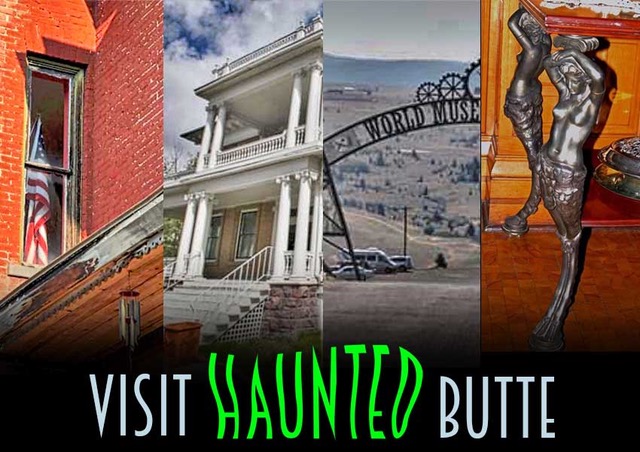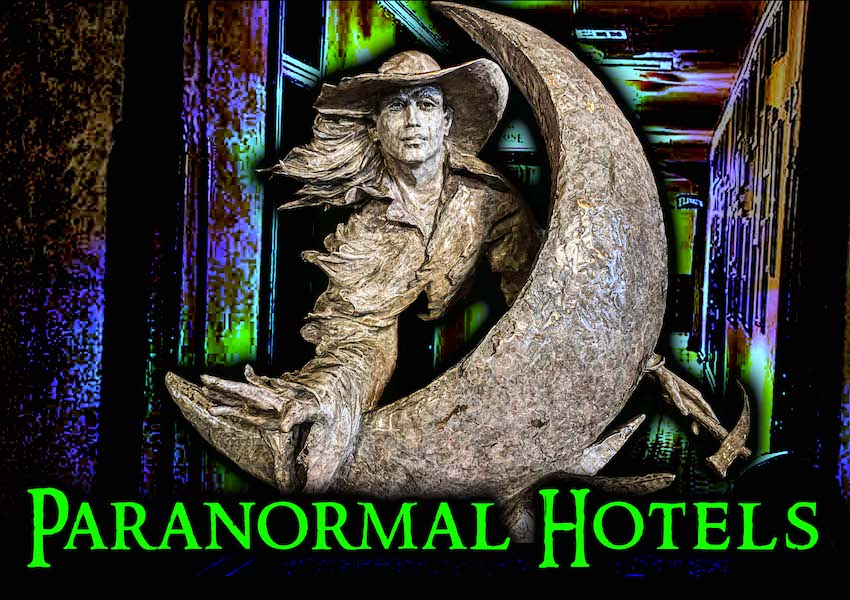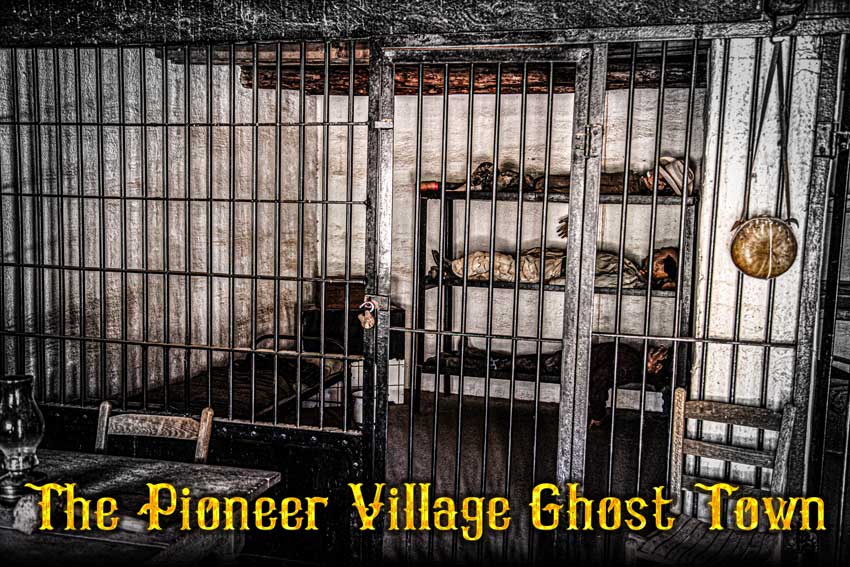Boise Idaho
Idaho State Penitentiary
A spectral prison for upset spirits still stuck in their guilt, suffering,
shame and humiliation of the worst kind, and brutal deaths.



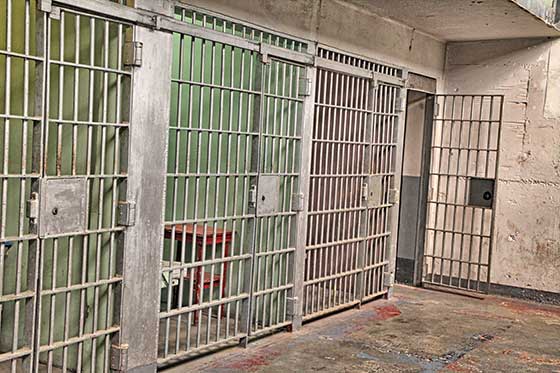


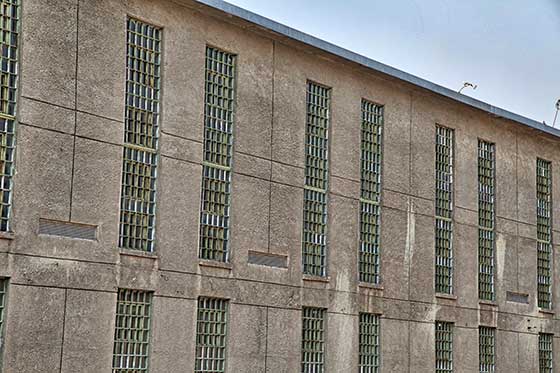







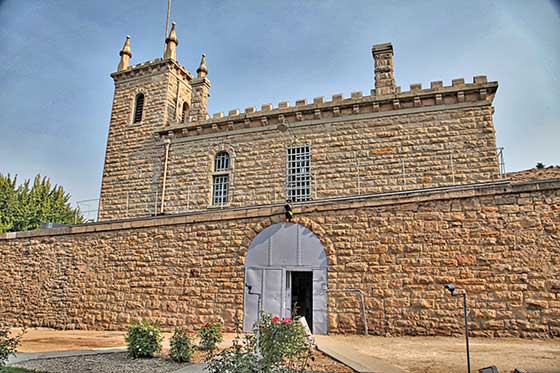




DESCRIPTION
Old Idaho State Penitentiary Museum: Tom and I really enjoyed walking around this interesting prison and learning a lot about life here. We came here twice on different trips, for pictures and to expand our story on hauntedhouses.com.
The prison buildings are exactly like they were when the prison was emptied of inmates in 1973. Buildings that burned down like the chapel are still in ruins. There are calendars on the cell walls, etc.
Sitting on 510 acres, Old Idaho State Penitentiary Museum buildings that were constructed before 1950 used locally quarried, cheap rusticated sandstone, to create handsome, Romanesque style buildings.

Between 1887 and 1968, the Idaho State Penitentiary housed two hundred and fourteen men incarcerated for Idaho crimes. Women had their separate prison, surrounded by a wall outside the main yard. The prison building was grouped with the Warden’s House, Guard House, and two large stone barns. The 1906 women’s prison was constructed of wood. In 1920, a new but crude concrete Cell House for women became the new women’s prison.
The Administration Building was built in 1894. It is described as a “rusticated two-story Romanesque with a squared three story tower in the manner of English Gothic churches; complete with four corner finials.”
The giant, round-arched entrance leads into a tunnel which delivers the visitor to the interior gates of the prison.
A lovely grassy area and Rose Garden is still there. On the self-directed tour, the visitor will notice that a portable scaffold was set up as a display in the prison’s Rose Garden area. This reflects the historical fact that the death penalty was only very occasionally carried out here before Cell House 5 was built.
The Old Idaho Penitentiary was a small city with basic everyday services, as well as having Cell House Blocks. Services over the years included a Dining Hall, Commissary, Hospital, Barber Shop, Laundry, Shoe Shop, Gymnasium, Library and Chapel, to name a few. They also had a Heating, Lighting and Pumping Plant, providing their own heat, electricity and water.
The Multipurpose Building was built in 1923, and over the years was home to a Shirt Factory, Laundry, License Plate Shop, Bakery, Shoe Shop, and Hobby Room. It also housed the Communal Shower.
The original 1870 prison, measuring 70′ 5″ x 40′ 4″, was later used as a chapel. It is described in the NRHP papers as being “a simple, rectangular building with “segmental arch windows and door.”
Cell House Blocks One and Two used to be one large Cell Block, but were made into two separate units when the central block was taken out. Each one had three stories of steel cells with tall, narrow barred openings.
Where did men go who couldn’t behave? The state’s Corrections Office decided that these hard-to-handle, trouble-making or anti-social inmates needed a different, harsher place to be housed, away from the other inmates.
 On the tour, the visitor can see a 1920s subterranean stone-walled dungeon with rings in the wall, a 1923 solitary confinement set up that put more than one inmate in a cell, and a severe 1926 solitary confinement block, called ‘Siberia’ made up of solid concrete walls, floors and ceilings, without light, water, plumbing or furniture. It was their version of “The Hole.” At least one man died in one of these cells.
On the tour, the visitor can see a 1920s subterranean stone-walled dungeon with rings in the wall, a 1923 solitary confinement set up that put more than one inmate in a cell, and a severe 1926 solitary confinement block, called ‘Siberia’ made up of solid concrete walls, floors and ceilings, without light, water, plumbing or furniture. It was their version of “The Hole.” At least one man died in one of these cells.
The last two cell house blocks have only two stories: 1951 Cell House Block Four and the Maximum Security 1954 Block Five. Both are ugly, with sterile concrete and steel construction. Both are described as being “a very severe utilitarian structure, devoid of grace and style.” They have flat roofs; not the best in hot weather but at least they were not made of sandstone, which has great disadvantages.
Cell House 5 was home to the worst of the worst inmates, who lived in refined solitary confinement cells on the first floor that each had a bed, toilet and sink. Inmates were locked up for 23 hours, and let out for an hour to either take a shower or go into the exercise yard. The second floor had the “Death Row” cells on the same floor as the 1950s Execution Chamber room, complete with a trap door.
The Old Idaho Penitentiary was first listed on the National Register of Historic Places in 1974, after prison authorities decided they would move the inmates to a newer facility in 1973.
Tom and I would love to visit again, and see the Penitentiary’s new exhibit that “Chronicles the lives and crimes of Idaho women who found themselves at odds with the law. Discover scandalous stories and escape attempts, and learn about daily life for female inmates.”
Also of interest, is the new crafts display of inmates’ hobby work that helped to give them a new way to make a living, called “Crafty Cons.”
HISTORY
The Idaho State Penitentiary was open from 1872-1973, and over the years was home to 13,000 inmates. Surprisingly, only one hundred and ten inmates died here. Seven were executed. No guards ever lost their lives on the job.
When the Idaho Territory was less than ten years old, the need for a prison became evident as crime was surging, and a rising tide of criminals needed to be kept away from civilized society.
In 1870, using prisoner labor, the first structures were built using hand-cut sandstone. The buildings were designed by an inmate, George Hamilton. Apparently, when he wasn’t busy robbing people on the highway, he was a skilled draftsman before he was incarcerated.
Other sandstone buildings are found in the center yard and include Cell House Blocks One, Two, and Three, the Commissary, the Barber Shop, the Hospital, the Chapel, and a Dining Hall/Kitchen, which are all part of the self-directed tour.
While the buildings were pleasing to the eye, conditions inside were intolerable. Unfortunately, sandstone walls retain heat in the summer, creating a “stifling oven effect”. In the winter, the sandstone walls held in the bitter cold, constantly chilling inmates. Proper plumbing throughout the prison wasn’t installed until the 1920s. The ventilation system was poor as well. Thus, a lot of inmates got sick with disease.
Around 1923, new buildings were built using stucco. A Multipurpose Building, originally a Shirt Factory, is quite a large rectangular structure. It was used for many things over Idaho State Pen’s long history. The Laundry and Communal Shower were also located here.
In 1923, a Solitary confinement building was needed for unruly inmates, so it was built, located in the left hand corner of the prison. Small, dark cells with beds and toilets were provided. Sometimes as many of four men were in one cell.
In 1926, a more severe solitary confinement structure was built, called “Siberia” by the inmates. They were small, dark cells with no light, no furniture, and no water. Conditions were brutal, and some may have died from the elements, or from weakened conditions.
 Inmates could be locked up from days to weeks, 30 days on the average. They were fed once a day, and could shower once a week. The only light they had came from a small opening at the top of the cell. Some inmates yelled constantly.
Inmates could be locked up from days to weeks, 30 days on the average. They were fed once a day, and could shower once a week. The only light they had came from a small opening at the top of the cell. Some inmates yelled constantly.
From 1870–1934 the Pen was free of prisoner riots. This ended in 1935, with a “melee” in the dining hall. Dishes and tables were thrown everywhere.
In 1952, major damage costing thousands of dollars to the Multipurpose Building resulted when two hundred and fifty guests of the state took over the building in protest when the warden broke his promise and sent four “ringleaders” to solitary after an unrelated incident.
In 1952 and 1954, the Multipurpose Building was repaired, and concrete and steel were used to construct two modern Cell Houses: Blocks Four and Five. Block Five had the Death Chamber room on the west side of the second floor near the end of the building.
However, only one inmate was hung there, in 1957: Raymond Snowden, who was convicted of murdering a woman, Cora Dean, with a pocket knife. Before he faced execution, he confessed to killing two other women. Unfortunately, there were kinks that needed to be worked out with the device, specifically with the length of rope used. The trap door also opened so violently that the glass in the observation booth shattered all over Cora’s family. Then, the fall through the trap door didn’t break Snowden’s neck, so he slowly strangled to death. It took fifteen minutes.
In 1966, there was a peaceful strike by three hundred inmates over better living conditions, and for the reopening of the Commissary. Things hadn’t changed with the times, the structures were old, and many felt the conditions were substandard.
In 1971, a very hostile, three-hour riot resulted in the looting of the Prison Hospital and Commissary, and the destruction of the Social Services Building by fire, amounting to around $25,000 in damage. Two inmates were shivved with hand-made knives and another was violated and killed brutally in the shower area.
In 1973, riots again broke out. Prisoners burned the chapel and dining hall to the ground and damaged many other buildings. Soon after this incident, all inmates were moved to a new, modern facility: the Idaho State Correctional Institution, located south of Boise. It was an updated modern prison (with air conditioning) that didn’t have the awful faults of the State Penitentiary.
The Old Idaho State Penitentiary was given a new purpose as a historical museum for the public, of interest because of the Romanesque style of the original beautiful sandstone buildings.
Some inmates never made it to the new prison, as they died in the old one. They seem to be serving an afterlife sentence here for a variety of reasons.
HISTORY OF MANIFESTATIONS
One hundred and ten inmates died here from old age, illness, suicide and at the hands of others. It is no wonder then that the joint is still jumping with activity from mostly friendly spirits, with only a few bad apples.
Suicide during incarceration has always been a problem in prisons because of the despair of prisoners, mental breakdowns and their not wanting to face punishment anymore.
Ohio State Reformatory, OH (Prisoners hung themselves in their cells.)
Alcatraz, CA (Inmates killed themselves here too.)
Cripple Creek Jail Museum, CO (A desperate inmate jumped over the railing, either not wanting to do hard time or because he was mentally ill.)
Idaho State Penitentiary, ID (An inmate on death row, Douglas Van Vlack, jumped to his death, not wanting to experience an execution for killing three people. Another inmate in Cell House Block 4 killed himself in his cell, not able to stand it any more. Three inmates killed themselves in Cell House Block Two.)
Prisoners who died at the hands of other prisoners or guards often are stuck as spirits where they were killed; because they want justice, deny to themselves that they are dead, and are afraid to go to the other side because of what they did in life.
Alcatraz, CA (Inmates were killed by others and suffered vicious beat-downs by guards.)
West Virginia Penitentiary, WV (Inmates were viciously killed by other inmates, others were raped and traumatized, and hard-to-handle inmates suffered near-fatal injuries.)
Ohio State Reformatory, OH (Inmates were lumped together, the mildly criminal with the nastiest inmates, which led to a lot of murder. Punishment was often harsh, and sometimes deadly.)
Idaho State Penitentiary (Men were killed by other inmates using hand-made knives called “shivs”, and in riots that happened at the prison.)
Prisoners who are executed sometimes remain in the prison in their afterlives for a variety of reasons, especially if their executions were cruel.
The MacArthur Military History Museum, AR (A 17-year-old Confederate soldier suffered a botched hanging and died a slow death of strangulation.)
Whaley House, CA (A bully suffered a bad hanging on the land where the Whaley House was built.)
Wyoming Frontier Prison, WY (Prisoners were forced to kill themselves on the Julien Gallows, frequently suffering painful deaths.)
Idaho State Penitentiary, ID (The first and only hanging in the Maximum Security Cell Block was a botched effort, causing the man to slowly strangle to death as described above. Also, there were six other inmates who were hung in the Rose Garden.)
When spirits are recognized by the living, they are sometimes drawn back into this world to enjoy their notoriety.
Harper’s Ferry, WV (The spirit of John Brown enjoys mingling amongst the tourists who give him positive feedback.)
Liberty Hall, KY (The spirit of Mrs. Varick enjoys serving the living here, finding purpose and peace.)
Captain Fairfield Inn, ME (The spirit of Captain Fairfield enjoys the fact that his portrait is still hanging in The Fairfield Inn)
Idaho State Penitentiary, ID (The posters of two notorious inmates, Cora and Harry, who were major crime offenders, made it up on a museum display depicting well-known inmates. Their spirits take pride in that, and have decided to stay and be helpful to visitors, especially mediums.)
Death doesn’t give people any new virtues. Mean and nasty personalities don’t change into kind and loving ones.
Irma Hotel, WY (A nasty guest from hell liked to bully people, even hanging them from his window. He still yearns to do so.)
OK Corral, AZ (The spirit of Billy Clanton is still a bully with the living in the OK Corral.)
Lucky’s Tavern, FL (The spirit of a mobster has volunteered to keep an eye on the staff in a rough manner.)
Idaho State Penitentiary, ID (Out of 13,000 inmates, only six were hung in the Rose Garden. Those six must have been really mean and nasty killers. Apparently, they haven’t changed.)
MANIFESTATIONS
Solitary Confinement building
1926 Siberia Cell House: Stringent Solitary Confinement
Cold spots and apparitions are seen here.
At least one spirit was still stuck in his cell.
The Rose Garden
Many spirits still find the Rose Garden a place of peace and respite. Some have fond memories of taking care of the plants, or enjoy the beautiful flowers that still bloom there.
A male spirit, dressed in prison issue gardening clothes, has been seen by visitors taking care of the plants. He resembles a living person.
Being the place where the portable gallows was set up during the early years, apparitions are seen here, spirits attached to their place of death.
They like to harass paranormal investigators around 3 o’clock in the morning, when they apparently have control of this area.
Moving cold spots are felt when it is hot outside and there is no wind.
Cell House Block 5
Maximum Security, and Death Row:
The spirit of inmate Douglas Van Vlack, who suicided, makes his presence known by causing batteries to go dead. He has been seen as a greenish light.
The spirit of Raymond Snowden who strangled to death in a botched hanging, still lingers near the death chamber, reliving his painful end. People hear an unseen presence gasping for air.
When a docent was standing on the trap door in the execution chamber, she heard the door to the stair way slam with a big bang, and all the lights went out on the second floor.
Other full-bodied apparitions have been seen here, reliving their incarceration.
The sound of cell doors closing is heard. This could be a residual loop.
The maximum security building has the heaviest negative energy, felt by many.
The Multipurpose Building
Unseen spirits go about their business here, perhaps reliving their good times or jobs.
The spirit of a man who was brutally raped and killed here in the shower room during the August 1971 riot still makes his presence known in benign ways.
He had a little fun with Aaron in the Ghost Adventures Investigation, as Aaron reacts so beautifully!
Residual energy also replays his repeated rape and multiple stabbings by a group of angry men.
The spirits of these angry men may be stuck here as well.
Cell House Block Four
The spirit of a suicide is still serving time here.
Other spirits keep him company, serving time too, stuck here for some reason.
Cell House Block Two
The spirit of a large, burley man, a “Big Louie” type on steroids, is not afraid of anyone: living or dead.
Known to shove staff/visitors in the back for fun!
Especially likes to bother mediums.
Three spirits who killed themselves here still are serving time.
Doing the deed may have given them peace at first, but they find themselves still stuck here.
There is residual energy from the prison riots.
Unpaid Museum Docents
A female spirit, Cora, and a male spirit, lifer Harry Orchard, are both enthusiastic about being in a museum exhibit. They volunteer to be unpaid docents, gladly showing mediums and other psychic folks around their prison home.
Cora is apparently on the welcoming committee at the front gate and was the spectral docent for the women’s prison.
Harry popped in and out, telling the medium Jennifer about each area the investigation visited.
PARANORMAL FINDINGS
The living have been having personal experiences in this very haunted place for many years.
Paranormal Investigators have never been disappointed here.
Medium Jennifer Von Behren and the Spokane Paranormal Investigation Group went to the Old Idaho State Penitentiary Museum to investigate. Jennifer reported “that the majority of that prison had some seriously crazy stuff going on!”
Right away as they entered they were greeted by a friendly female spirit, Cora, who showed them the women’s prison, and told the medium that the crying heard by the medium was from a spirit who had killed her baby.
Jennifer then met their unofficial guide, an enthusiastic spirit called Harry who stayed with her, popping in and out during their investigation.
In “Siberia”, she talked to a spirit still staying in his cell. She said she did some “work” with him.
In the shower room, she saw the residual energy of a man being raped by several others and then stabbed to death.
In one of the cell blocks, she talked to a man called Jake, who was polite and friendly.
The Spokane Paranormal Investigation Group caught a lot of hard evidence making them extremely happy.
One of many successes was an interaction with Jake, using the flashlight method. Harry also jumped in and had fun with the flashlights too. Both spirits answered the yes/no questions of the investigators.
In Cell House Block Two, Jennifer was warned to stay outside, so she did. She was given a vision of the big man, and felt his threatening presence. She was glad she didn’t go inside. SPIG came out of this Cell House extremely excited, having caught a boatload of evidence.
Ghost Adventures: Season two: Ghosts of Seasons Past summary.
SPIG caught a picture of a shadow with an executiontioner’s hood over its head on a TV screen using ITC technology with a video camera.
Season 2: Episode 8- Old Idaho State Penitentiary
When they started their walk around, they heard disembodied screaming and laughter.
When Aaron was locked in the shower room, a spirit was filmed taking a water bottle out of his back pocket in fun. Aaron also felt unseen, unfriendly presences watching him.
Solitary Confinement: Nick went into a Solitary Confinement cell and recorded an EVP “Hey say what?” Static cameras caught slamming doors. Unexplained words were captured as well.
In Cell House Block 5, Zac stayed in Raymond’s Death Row cell. A dark mist stood behind him and touched his shoulder, giving him the chills.
Zac was in the Rose Garden at 3:00 AM, and felt someone was giving him a headache. A similar event happened with another investigator who felt unseen hands squeezing his head.
STILL HAUNTED?
A Big Yes Indeed!
Much hard evidence has been caught by paranormal investigators. Through psychic investigations, mediums have talked to and seen spirits here as well. Personal experiences with these spirits readily happen, as the spirits like to interact with the living. Two of these spirits are flattered that they are still remembered and their photos made it to a museum exhibit.




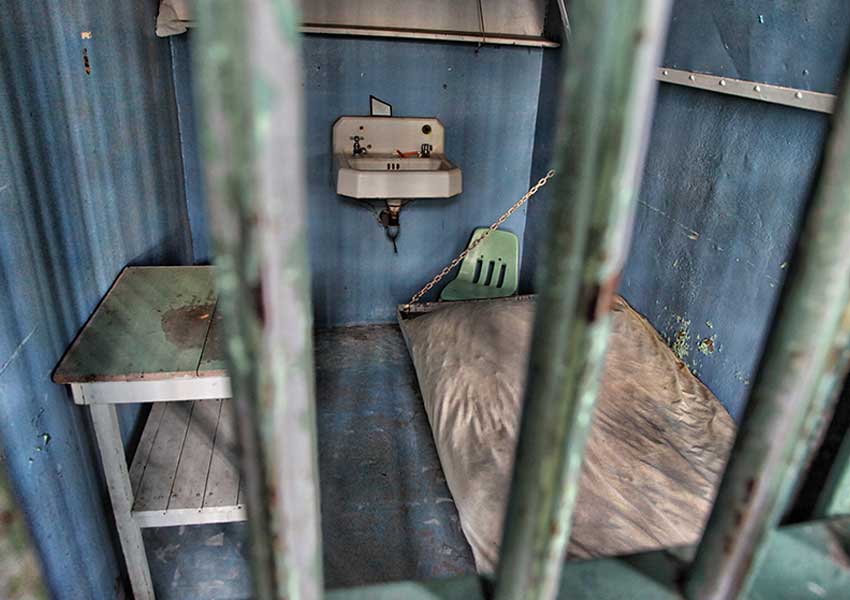



LOCATION
1109 Main Street
Boise, Idaho 83702
(208) 334-2844
Old Idaho State Penitentiary Museum is located off of Warm Springs Avenue in East Boise, at the base of Table Rock.
Free parking is available behind the Bishops’ House in the dirt parking lot.

SOURCES INCLUDE
- The Ghost Hunters Field Guide, by Rich Newman, Llewellyn Productions, 2016.
- Travel Channel website pages
- Ghost Adventures, Season 2, Episode 8: Idaho State Penitentiary, 2009 and
- Recap of Ghost Adventures Idaho State Penitentiary
- Ghost Adventures articles: “Old Idaho state Penitentiary Haunted History”
- The dead history website: Old Idaho State Penitentiary
- “Ghostly Inmates of the Old Idaho Penitentiary,” by Jenifer Jones, July 13th, 2016
- Jennifer Von Behren website
Haunting Investigation at the Idaho State Penitentiary in Boise, Idaho with Jennifer Von Behren and S.P.I.G., August 2016. Spokane Paranormal Investigation Group
Our Haunted Paranormal Stories are Written by Julie Carr
Our Photos are copyrighted by Tom Carr
Visit the memorable… Milwaukee Haunted Hotel
Your Paranormal Road Trip











